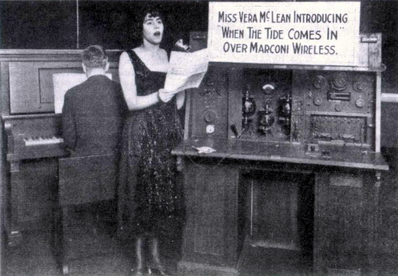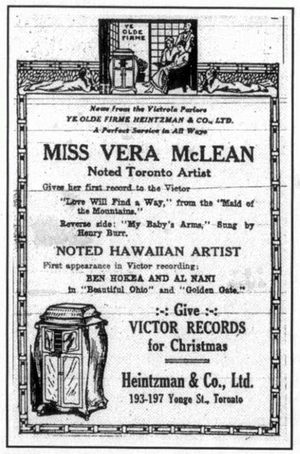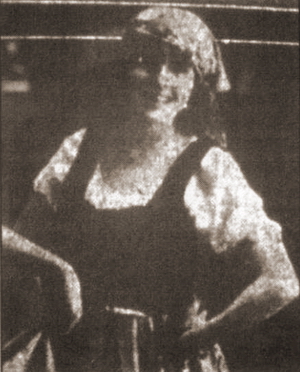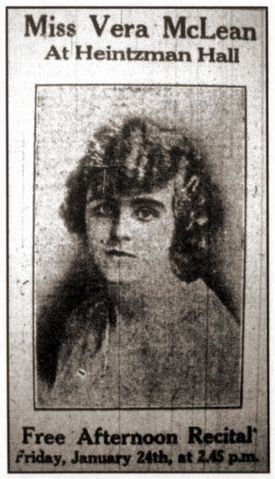|
Vera McLean - A Canadian Recording Artist of the Acoustic Era
by Arthur E. Zimmerman
Miss Vera McLean, the Toronto contralto,
introducing the new Feist hit "When the Tide
Comes In" over the Marconi wireless
telephone at 93 King Street East in Toronto.
Miss McLean is standing beside the station's
Marconi YC3 transmitter, singing into a
candlestick
telephone-like
microphone, and
that's possibly Dr. MacMillan at the piano.
(Can. Music Trades J. XXII #10, March 1922,
p.75;
National Library of Canada,
negative number NL 2977)

|
|
Quite early in my research on the beginnings of
the Montreal Marconi radio station XWA /
CFCEF,I re-discovered the photograph titled
"Miss Vera McLean broadcasting over Marconi
Wireless, Montreal" (Edward B. Moogk, "Roll Back
the Years", page 93, National Library of Canada, 1975).
The book also lists two recordings that Vera
McLean had made for Herbert Berliner’s
Canadian black label HMV series, "Love Will Find a
Way" from "Maid of the Mountains" (216072-B) and
"Bye-Lo" (216080-B).
Who was Vera McLean and why was she chosen to
record acoustically for Berliner and to sing over the
radio? The Music Division of the National Library of
Canada in Ottawa does not have a vertical file on her,
and the Encyclopaedia of Music in Canada has one
brief mention in an article about one of her teachers.
The first break came when I found an article in
Maclean's Magazine that stated, "....radio concerts in
which the Toronto Marconi station transmitted for the
patrons of the C.N.E. of 1921, and the introduction to
the public of the song ‘When the Tide Comes In’, the
first to be brought to their notice via radio." ("Putting
Canada 'On the Air'" by Donald E. Bankart,
Maclean's, Nov. 15, 1926, p. 14) So, now there was a
question about Montreal’s being the broadcast
location given in Ed Moogk’s caption to the photo.
At that point I did not know that there had been a
short-lived Marconi public broadcasting station in
Toronto, and wondered whether "When the Tide
Comes In" can have been introduced to the public
over Marconi radio that early in both Montreal and
Toronto. Consulting an early edition of "Official List
of Radio Stations of Canada", August 1,1922, I found
that there was indeed a Toronto Marconi station,
CHCB, at 93 King Street East, operated by Mr.
George Frederick Eaton, a former Marconi coastal
telegraph operator who hailed from the Maritimes. In
the 1922 edition of Might’s Toronto City Directories
(compiled in 1921), I found Miss Vera McLean listed
as living with her family at 23 Braemore Gardens.
The arts section of the Metropolitan Toronto Reference
Library has original programs of four
concerts by Miss McLean, including one in which she
was the contralto soloist in Brahms' "Alto Rhapsody"
- a very demanding and difficult solo - with the
Timothy Eaton Memorial Church Choir directed by
Dr. Ernest MacMillan! She must have been a special
artist, because she also gave concerts with such
notables as the great English oratorio basso Robert
Watkin-Mills*, with bass-baritone Ruthven Macdonald**,
with violinist/conductor Luigi von Kunits and the Academy
String Quartet, with violinists Louis Gesensway and Frank Blachford,
with cellist Boris Hambourg**, with the brilliant young pianist Muriel
Kerr***, and with Dr. Ernest MacMillan*** and his conservatory colleagues. She
also appeared as Tessa in the Savoyards Company production of "The
Gondoliers", conducted by Reginald Stewart, and as contralto soloist in concert
performances in Ottawa and Buffalo.
Announcement by Ye Olde Firme Heintzman and Company,
Ltd,, of the release of Vera McLean's first recorded side,
which she "gave" to the Victor. The release date was
December 31, 1919.
(Evening Telegram, Toronto,
December 20, 1919, p. 27; ibid., December 31, 1919, p. 11)

|
|
Miss Vera McLean was obviously a considerable artist, but could anything
more be discovered about her? I asked senior members of CAPS whether
they had ever heard of her, and showed around the Marconi photo
and disc entries in "Roll Back the Years". John
Black recalled that he had made tape copies of Vera
McLean's two recorded sides for her daughter, maybe
10 or 12 years before, and he still had her telephone
number. So, I called Mrs. Elizabeth White and got the
rest of the story, plus more leads to explore.
The singer was born Florence Vera McLean on
October 21, 1895, in Toronto, and lived with her
parents and her sister, first on lower Bathurst Street
and later on Braemore Gardens. Her father was an
executive in a meat packing company and later with
National Grocers. After her maternal grandmother
(Susannah Jane Gardiner Baker) died, circa 1906,
Vera’s mother (Florence Elizabeth Baker McLean)
had a nervous breakdown, and Vera had to stay home
for a couple of years to take care of her. A few years
later, Vera left Central Technical School at 16 to pursue
her singing ambitions and she never
completed her formal education. She studied voice
with James Quarrington until at least 1919, and after
that with Miss Hope Morgan. Her first singing jobs
were as soloist with Park Lawn Church and with St.
James Square Presbyterian Church and from 1920 to
1924 she was soloist with the Timothy Eaton
Memorial Church. Apparently, Dr. Ernest MacMillan
used to bring in newly written pieces for his choir and
soloists on Thursday for first rehearsal on Friday and
performance on Sunday. That must have made life
rough for Vera who was always very, very nervous
before going onstage. In 1919 and 1920, she sang
daily in several month-long promotional series for the
T. Eaton Company in its "Jubilee Park" tea garden
(with waterfall and lagoon) on the main floor
of the old Annex, then in Eaton’s Amphion Phonograph Concerts,
in Heintzman & Company store and in other venues around the
city. By the early 1920's she was a very popular artist on the Toronto
concert scene, appearing in recital sometimes two or three times in a single
week - at Massey Hall, Canadian Forresters Hall, the
Masonic Hall and the King Edward Hotel Concert Hall.
Elizabeth White points out that, around 1922, women
tied down their breasts in the flapper fashion,
but when Vera sang in public she "unleashed her ample
bosom" to be able to take in big breaths. She
illustrated by taking in an enormous breath, the way
her mother did.
Herbert Berliner, vice-President of the Berliner Gramophone Co., Ltd.,
Montreal, announced in the fall of 1919 that his company "has produced quite an
extensive list of Canadian recordings and which list will be greatly enlarged in the very
near future". (Canadian Music Trades Journal, October 1919, p.
69) So, Vera McLean's two recorded 10-inch sides for Canadian
HMV, released in December 1919 and January 1920, must have been recorded by Berliner in mid-1919. Heintzman & Company’s pre-release
advertisement announced "Miss Vera McLean, Noted
Toronto Artist, gives her first record to the Victor".
(Evening Telegram, Toronto, December 20, 1919, p. 27)
Vera McLean in costume as Tessa in the
Savoyards production of Gilbert and
Sullivan's "The Gondoliers"
(Toronto
Daily Star, May13, 1922, p. 17)

|
|
Vera married a young lawyer, William Ewart Sommerville, on
June 14, 1921, and they had three children over the next
11 years. She continued her career following the births of her two
boys and, with the encouragement of her husband, was planning to
go to New York in 1927 to take master classes.
Somehow that did not happen and her public
appearances became less frequent. Both boys got very sick
several summers later, and from that point Vera McLean
sang very little in public. Elizabeth, the youngest, remembers
her mother giving singing lessons to friends in the family living room,
and also recalls that the three children were always embarrassed
when Vera stood up with the congregation in church, drew in an enormous breath
and sang really LOUD! It must have been a magnificent sound.
Elizabeth White produced, from her mother’s
scrapbook, a small collection of reviews and early
photos plus a treasure that I had been unable to find
anywhere: the original newspaper clipping of the
photo taken in the Marconi studio with the original
caption, proving that the Marconi broadcast had
happened at their offices at 93 King Street East in
Toronto. The photo was taken on a C.N.E. Tuesday,
either August 30 or September 6, 1921, and the
broadcast was heard at the fair from five big Magnavox
megaphones mounted around the flagpole
near the main band stand, as well as "by thousands
listening at hundreds of points across Canada.....and
by the Marconi offices in New York....". A careful
examination of a good copy of the photograph makes
me suspect that the accompanist on that occasion may
well have been Dr. Ernest MacMillan himself!
Vera McLean loved Scottish songs and sacred music, as
is evident in her many concert programs and ten traceable
radio broadcasts. The first broadcast was in 1921 over CHCB,
the one that was photographed and heard at the C.NE. grounds
from loudspeakers around the central flagpole. She sang twice on The
Daily Star’s concerts over 9AH and CKCE (the radio stations of
the Canadian Independent Telephone Company, on April 4
and May 23, 1922), several times over CFCA (The Toronto
Star station, in 1924 and 1925), once on CHNC (the station of
the Toronto Radio Research Society, on January 25,
1925), and once in 1930 as the guest artist on the
CNR Transcontinental Hour, relayed from Ottawa over CNRT.
Newspaper announcement of a recital to be given by Miss
Vera McLean "in the new Victrola Parlors" of Heintzman
Hall, Toronto. The caption states, "Miss McLean is too
well-known in Toronto to need much introduction."
(Toronto Daily Star, January 23, 1919, page 4)

|
|
The few reviews I found were close to ecstatic: "...sang ...gloriously";
"in ...splendid voice"; "fine contralto voice"; "People like her voice
not only because of its pleasing quality, but because she sings
with so much skill and expression"; "....her rich resonant contralto voice,
big in range and dramatic in quality...."; ".....pure and powerful contralto voice....";
".....hitherto regarded as a phenomenal voice, is now on the verge of being
a wonderful singer....its remarkable low tones of such soft texture and deep
resonance, its middle register of gorgeous colouring and its upper register of
thrilling vitality...."; ".....whose beautiful voice has delighted thousands of
concert patrons"; and "I greatly enjoyed Miss Vera McLean's singing
- she has such a perfect radio voice". Augustus Bridle of The Daily Star, however,
ground her down in his nasty way, writing:
"Miss Vera McLean was the assisting artist, as
usual in superb voice. Miss McLean has a
voice that nobody fails to admire. It is
instantly impressive. She has a tonal utterance
that is rarely excelled in quality, whatever it
lacks in style and ethereal charm and occasional
brilliance. Gradually as she progresses Miss McLean becomes more and
more flexible and capable of artistry. She demonstrates the value
of hard work as applied in a voice that would make some people negligent."
From the quality of the voice on her records, Bridle was being
much too harsh with a promising young singer.
Another reviewer predicted that she had the potential to become one of
the finest ballad and oratorio contraltos in America.
Elizabeth White says that her mother was jaunty and
spirited, with quite a temper, but was not terribly
secure. She led a family- and community-oriented life
following her brief singing career. She had many friends and enjoyed bridge,
travel and her "Silent Seven” sewing group, which met to make coats for
British children in WW II. Her husband Bill died in
1971, but Vera carried on and seemed to find new
strengths. She spent her last years in some lovely
seniors’ residences, eventually suffering from failing eyesight.
Elizabeth remembers a man coming up to
her in those years and saying, "You're Vera McLean,
aren’t you? I used to travel by streetcar to hear your
concerts." Florence Vera McLean Sommerville died
on July 5, 1989, almost 94 years old.
I would be fascinated to know who introduced Vera
McLean to Herbert Berliner in 1919, and also who
recommended her to the Marconi broadcasters for the
C.N.E. demonstration in 1921.
NOTES:
* Robert Watkin-Mills recorded for Odeon and Pathé
** Ruthven Macdonald and Boris Hambourg recorded for Canadian Victor
*** Muriel Kerr and Sir Ernest MacMillan recorded for RCA Victor
The author wishes to thank John Black for his
assistance and Bill Pratt for taking the photos.
Arthur E. Zimmerman is author of "In the Shadow of
the Shield" (hardcover, 657 pages), a fully documented oral history of wireless
and radio broadcasting at Queen’s University and in Kingston,
Ontario, 1902-1957. It has been called one of the
very best books on regional radio in Canada. He is
currently researching and writing a book on the
earliest years of the Montreal and Toronto Marconi
radio stations, XWA / CFCF and CHCB, respectively,
and is looking for copies of early Canadian radio
magazines, especially Canadian Wireless (June 1921
- July 1922). He can be reached by telephone at
(416)-923-2001 or by e-mail at arthurz@look.ca
|